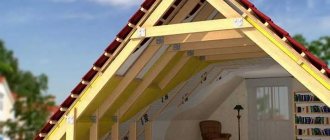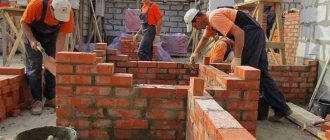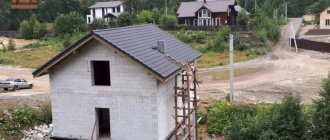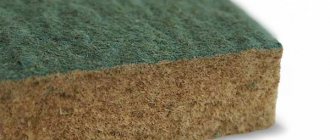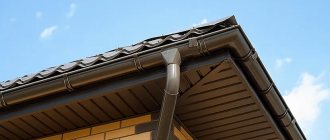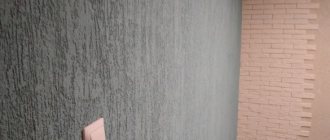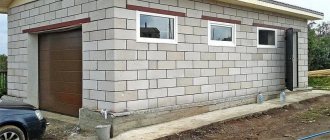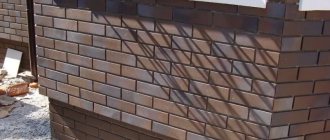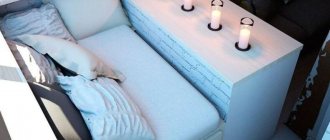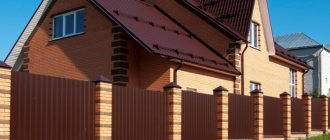A wooden house is a separate category of construction. Its smell takes us back to childhood, and the atmosphere that is created inside fills us with comfort and gives us a feeling of calm and tranquility. Log houses are easy to live in, maintain a comfortable climate, and their environmental friendliness is good for health. In order to obtain all these effects upon completion of the building construction process, you need to understand how to properly build a log house and what features it has.
A log house built according to all the rules will become a real fortress for its owners Source www.vladtime.ru
Choice of material: rounded log house or planed (chopped) log
All log houses are divided into 2 types of buildings :
- buildings made of planed logs , that is, those that were processed by hand;
- buildings that are built from rounded logs .
In order to understand how to properly build a house from a log, you need to have an idea not only of the external difference between the 1st warrant and the 2nd, but also the structural one.
"Wild log house"
The history of architecture tells us that all log houses that were erected before the end of the 19th century were built from a “wild log”. This meant that the future building material was processed manually. The freshly cut log was stripped of its bark, while the bast layer should remain intact. It was he who protected the wood and its deep layers from moisture. This provided the log houses with reliable protection from fungus and mold, and increased their “service life” significantly.
The main feature of the “wild log” house was its bright and expressive shape. Non-cylindered beams gave such individuality. A sawn log tends to taper from bottom to top. After processing the wood with tools, such a difference in diameter still remained. The farther from the end, which was located at the roots, the thicker the log.
Houses made from “wild” logs completely bring their owners closer to nature Source stroy-podskazka.ru
A tall tree can be processed and divided into several logs. Sometimes it produces 2 building elements, but the ideal would be to obtain 3 parts.
The classic rule for dividing timber is as follows:
- 1 log – butt . This is the part that is located closer to the roots;
- 2 log - friend . This is the middle part of the wood;
- 3 beam - third or top . Accordingly, this is the last part of the log that approached the top.
For the construction of the house, 1 part was used - the butt. The log house in this place was the thickest, had high strength and the smallest change in diameter. And in order to compensate for those differences that remained, the beams were alternated when laying the walls: in one row the butt “looks” in one direction, in the next in the opposite direction.
When laying timber, each top log lies on the previous one with the opposite side Source en.teremki74.ru
But, despite such opportunities to simplify the construction of a house from chopped wood, you should approach the selection of building materials very carefully. After all, you need to reproduce an even and durable structure from logs of different diameters. And this is not a simple task for them.
The construction technology itself has remained virtually unchanged since those times. Houses are built using the same method: “wild logs” of different diameters are adjusted as close to each other as possible. It should be noted that houses built in this way are classified as elite and differ in price. This is dictated by a certain complexity and labor intensity of the process. After all, after erecting the frame, the house should last from 1 to 2 years. During this period, it will “shrink” in height to 10%. This factor should also be taken into account during design. So, in addition to spending time and effort on selecting building materials, it will take a lot of time and patience to see the result.
In the completed house you can see the location of the logs in relation to each other Source domsireni.ru
See also: Catalog of wooden house projects presented at the Low-Rise Country exhibition.
Rounded log
A rounded log house is a planed log in an industrial environment. On machines, the wood is brought to an ideal state: it becomes smooth and even along its entire length. On special machines, all the necessary grooves for fastening are cut into the timber. In this case, the dimensions are adjusted to the nearest millimeter, which minimizes inconvenience during construction. Building a house using such a log house is similar to assembling a children's construction set.
Rounded logs are made approximately the same size Source goldenpackrus.ru
For all its convenience, a rounded log house also has disadvantages. Ideal evenness in size and smoothness is achieved by removing several levels of wood. During the production process, “useful” layers (sapwood) are also removed, which protect the log from moisture, fungus and mold. Only the mature and hearty central part of the tree remains. It is not protected in any way from external factors. Under such conditions, it is necessary to additionally impregnate the timber with antiseptics, antifungal and anthelmintic drugs. The result is a beautiful and lightweight material for building a house. The downside is the low level of environmental friendliness and, oddly enough, durability.
Walls made of rounded timber look smooth and more neat Source profdomstroy.com
Selection of material for construction
In order to properly build a house from rounded logs, you need to know how to choose it and which material is more suitable in your region. Coniferous wood is most suitable for log houses. These are trees such as pine, spruce, cedar and larch. But if there are no desired options on the market, you can use oak, ash, aspen and other hardwoods. Spruce and pine are the most affordable in the price category. For this reason, they are the most popular.
The trunks of coniferous trees are smoother and easier to process. Source dachnaya-zhizn.ru
When choosing this type of building material, the period of the log house is very important. It is necessary to choose timber that was prepared in winter. It is he who has the best moisture resistance indicators.
The region where the tree grows is also important. If possible, choose wood from the northern regions. This material is the most durable. Good options: Baltic pine and Canadian spruce. The option of coniferous wood, which was properly harvested in compliance with all conditions and requirements, from the central regions is also very good.
Please note that the choice of beam diameter depends not only on the design decision, but also on climatic conditions. The main criterion is the maximum temperature in the winter season.
Recommendations for choosing logs according to temperature:
- if winter in your region is not lower than -20 degrees , you can stop at a diameter of 200 mm;
- when the winter maximum is -30 degrees – 220 mm;
- if the thermometer is down to -40 , choose a log that is at least 240-260 mm or more.
To lay the log house, special equipment is used, which facilitates the construction of the house Source sibirsrub.ru
The thickness of the log for building a house in the northern regions must be at least 25 cm Source master-profy12.ru
The main parameters of the log and its cuts are indicated in the table Source 90zavod.ru
It is also worth noting that by choosing a beam with a slightly larger diameter than recommended according to the climate zone, it perfectly compensates for temperature changes. The main thing is not to choose a material less than specified. Despite the fact that the house will be insulated by laying a jute or flax-jute gasket between the logs, it will not be able to provide the comfortable temperature that a log of the required size can provide.
Additional criteria that you need to pay attention to when choosing a log house:
- high-quality log of yellow or dark yellow color ;
- there should be no stains on the cut
- In good material, the core is dark in color and occupies ¾ of the cut;
- It’s good when knots , and if they are present, they should fit tightly without gaps. The opposite picture indicates a damaged core;
- The best sound for a log is a ringing one. Try hitting the end with an ax and listen to how it rings;
- the presence of cracks is possible provided that their depth is no more than 1/3 of the log;
- the timber should not be twisted: such a log during the construction of a house can only be used for laying the floor - for this it is cut into boards and bars.
The timber is selected according to several criteria; if at least one does not meet the standard, the material is changed to the required one Source fotostrana.ru
Marking - according to GOST
The main document that you should familiarize yourself with before choosing a log house today is GOST 2292-88 - “Round timber. Labeling, sorting, transportation, measurement methods and acceptance.” GOST 32594-2013, which describes measurement methods, is also useful (for example, there is an interesting table here that describes in detail how much wood in cubic meters is contained in lumber of a given thickness and length).
Photo: blog.marisrub.ru
Logs in a log house must be marked (each log, according to GOST, must be marked if the diameter of the log is more than 14 cm and the length is more than 2 meters). The marking is applied to the upper end of the log using a durable material (waterproof paint or special crayons). The main thing is that the label reaches the consumer in a legible state. The size of the marking should be at least 3-5 cm.
The marking must necessarily contain the following information: grade (from first to fourth, indicated by Roman or Arabic numerals) and thickness. Thickness is indicated in a more cunning way: in Arabic numerals, using the last digit of the thickness number:
- if the log thickness is 20, 30, 40, 50 cm and so on, the thickness marking will be 0;
- if the thickness is 22, 32, 42, 52, etc. — thickness is marked with the Arabic numeral 2;
- if the thickness is 14, 24, 34, etc. — GOST requires marking 4;
- Markings 6 and 8 are applied in similar cases.
GOST, which regulates the acceptance of lumber, describes the features of their acceptance. But in our case, if we choose a ready-made log house, its manufacturer is responsible for acceptance. However, it will also be useful for you to familiarize yourself with this section.
Video description
Without knowing the technology of building a house, it is easy to make many mistakes. About them in the video:
Foundation
The main and most important element of any building is the foundation. Its depth and character depend on the soil on which the house will stand, on the nature of the wall material and on the number of storeys.
A log house is relatively light in weight. This design quality allows the foundation to be shallow. Almost all options for existing types of foundations are suitable for constructing a log house. Often they make a tape version. For difficult soils, a deep strip foundation or a pile foundation is used. You can also make a slab version.
It is worth noting that any version of the foundation should go 300-400 mm into the ground. After pouring it and completely drying, it is necessary to carry out waterproofing (roofing felt with mastic). This is a very important process despite the fact that the house is made of logs.
If a strip foundation is used, it begins with the arrangement of formwork Source bel-dom-stroy.ru
When the foundation is ready, they begin laying the walls Source fabrikadomov.by
Walling
Upon completion of the foundation laying stage, they move on to the main thing - the construction of walls. It is important to know that the first crown (the first row of logs) is never placed directly on the foundation. First, a “backing” board is laid. It is made from linden timber 50-100 mm thick and at least 150 mm wide. Then they move on to assembling the walls from the rounded log house.
Mortgage crown on a shallow monolithic foundation Source domsireni.ru
The first mortgage crown must be cut from below. Its end should match the width of the backing board. This is necessary so that the house rests firmly on the foundation.
Logs for walls are laid in circles (crowns). First, logs are laid that are parallel to each other. Then the other two sides, and insulation is laid on top. It is attached to the log using a construction stapler and should hang down at the edges by 5 cm.
Then the transverse sides of the house are laid, which will rest on the mortgage crown. And we repeat the “procedure” of assembling the house like a construction set.
The assembly of the house is carried out like a “constructor”: each log has its own place Source tula.stroimdom.com
Each of the logs has its own number, which makes it easy to determine where the timber should be located Source saw-wood.ru
The walls of the house smoothly merge into the end of the roof Source domsireni.ru
Own production
If you wish, you can receive sawn logs for free. Skyrim, fortunately, is not without such an opportunity. To do this, you need to go to the sawmill, talk to its owner and ask him for permission to produce firewood. He will not agree right away, so you will first have to appease the artisan in some way. For example, you can work as a lumberjack for a certain period of time and thus improve your relationship.
After you agree with the owner, he will allow you to use the sawmill and process the logs with your own hands. After each production cycle, you will receive 10 units of product without spending money on it. This method will allow you to save a tidy sum, although it will require much more time.
Caulk of a log house
Caulking a house is a separate important stage in its construction. Upon completion of the construction of the walls and roof, it is necessary to caulk all the insulation that was initially laid between the logs inside. To do this, using a special caulking tool, wrap the hanging 5 cm of the gasket downwards, and then push it inside between the cracks of the logs.
Having completed the caulking and roofing, the house is left to settle for a year. After a year, the caulking of the walls must be repeated. Some experts recommend repeating the “procedure” after a year of using the house with the heating on.
The insulation placed between the beams must be hidden Source vi.decorexpro.com
After caulking, the insulation is almost invisible, and there is no draft in the house Source uteplovdome.ru
Installation of doors, windows, installation of ceilings and floors
Important points when installing doors and windows is that they are installed only after the house has completely settled and only in special casing boxes that are installed in openings in the walls.
Installation of doors and windows is carried out after complete shrinkage of the log house, with the exception of houses made of kiln-dried logs - in this case they can be installed immediately Source perekrasimdom.by
Such precautions are due to the fact that wood is a “living” building material and will completely shrink in size in another 5-7 years.
The floor is installed on logs that cut into the first, or better yet, the second crown. The mortgage crown must be well ventilated in order to be subject to rotting processes as little as possible.
After installing the entrance doors, windows and laying the floor, you can install a heating system, conduct communications, connect the electrics, as well as install interior doors, slopes, baseboards and install plumbing.
There is no need to finish the walls. After all, the beauty of a log house is not only outside, but also inside. The bas-relief of slightly yellowish walls will fit into almost any interior. The main thing is to correctly emphasize the texture of the wood and complement the design with the necessary accessories. And your dream home is ready!
A log house in the forest over the water is a great place to relax from the hustle and bustle of the countryside Source houzz.com
The inside of the house does not require additional finishing, and natural wood can complement the stone Source houzz.com
One-story house made of hand-cut logs combined with stone trim Source pinterest.ca
The first floor is built of stone, the second - of logs: this combination also looks great Source houzz.es
Construction price
To accurately calculate the cost of materials, you need to take into account the following factors:
- dimensions of the house (length, height);
- number of interior walls;
- type of foundation and brand of cement (granite or gravel);
- presence of a stove;
- cost of the project (architect services);
- preparation of documents (entry into the cadastral register);
- selected wood species;
- quality of antiseptic agents and fire-fighting mixtures, as well as paint and varnish coating;
- workforce of at least 4 people;
- possible involvement of special equipment (manipulator).
Thus, we get the approximate cost of basic materials:
Pouring a foundation of 1 m³ - 3,200-3,800 rubles.- A cube of chopped wood up to 220 mm – 16-17,000 rubles.
- Cube of chopped wood 250-500 mm – 17-18,500 rubles.
- Brick for the stove for 1 piece. – 9-13 rub.
- Ruberoid – 500 rub./roll.
- Mineral wool – 1,500-4,500 rubles/roll.
- Vapor barrier – RUB 1,400/roll.
- Fire retardants – RUB 1,200/10 l.
- Antiseptics 250-350 rub./kg.
- Workers' services cost about 10,000 rubles per person.
If you contact a construction team, the cost of a house made of chopped logs is calculated per 1 m². So, assembly plus material with a temporary roof costs 6,000-15,000 rubles. Turnkey house with finishing and roof from 16,000 to 26,300 rubles.
How to choose a log for construction
It is recommended to buy logs from manufacturers who themselves are engaged in construction.
Preference is given to companies that simultaneously produce the material and carry out construction . They take a responsible approach to the quality of logs. Before placing an order, it is better to find out about the place of extraction of raw materials, storage and delivery conditions .
Externally, quality is distinguished by the following characteristics :
- material in dark yellow and yellow colors;
- no wormholes, resin pockets, mechanical defects;
- a few small knots are acceptable;
- the cuts are straight, the trunks are not twisted;
- all workpieces are of the same radius and length.
When accepting logs from the supplier, check for markings in accordance with the project, otherwise installation will be difficult.
Pros and cons of use
Chopped material has many advantages:
Thanks to the manual method of wood processing, fewer cracks form during drying.
This is because when hand-cut, a protective layer called sapwood is preserved, which prevents the wood from cracking and twisting, unlike a rounded sample.- The wood retains its natural shape – cone-shaped. During construction, the top and butt are alternated, preserving the tree as it grows in nature. This gives the log house a special and unique appearance.
- Natural material has a positive effect on the health of home owners. A bathhouse made from chopped material is also useful.
- It is warm in a log house in winter, and cool in summer.
- Properly prepared material practically does not absorb moisture, does not rot, and does not form mold.
- Due to the resin content in the protective layer, the material is resistant to ultraviolet rays and is less susceptible to insects.
- When building a house from chopped material, wind protection technology and shrinkage resistance are used, which cannot be used with rounded samples.
- Houses can be built from chopped logs in various styles: Russian, Finnish. And also use different types of corners: paw, triple, notch and others.
- A structure made of chopped wood does not require additional finishing - it decorates itself.
Disadvantages include::
- Due to the high cost of hand-processed materials, a house made of chopped logs will cost 25-30% more than a similar structure made of rounded logs.
- A longer shrinkage time for the house (about a year), during which interior finishing work cannot begin.
- Due to the imperfectly equal diameter of the trunks, the walls require additional sealing of the cracks.
